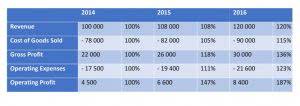Catch Up Bookkeeping: Quick Guide to Fix Year-end Financials

If your business operates using a cash basis accounting method, you only need to send the customer an invoice once they have paid. If your business uses an accrual basis accounting method, you record the amount in your books the moment the sale occurs, even if you haven’t received the cash yet. Say you made a $1000 sale in October 2020, but you weren’t paid until February 2021. As tempting as it is to ignore, it’s worth catching up on overdue bookkeeping well before tax season rolls around. Having tax-ready books can help you comply with IRS recordkeeping requirements and file an effective tax return.
Profitjets Help Businesses with Catch Up Bookkeeping
One of the most essential services a bookkeeper can provide for a business owner is to keep the company’s books accurate and up-to-date. Being able to quickly and easily review the status of your finances is crucial to short and long-term success for any business owner. When you know the health of your finances, you can make quicker decisions concerning everything from who to hire next to what marketing strategy recently worked best.
Transform Accounting Process
If not, then for the duration you’ve been using these modes of payment, you haven’t been tracking the money going in or out. You may need to hire a bookkeeper to reconcile all the digital and physical receipts of expenses, invoices, and other transaction records into your general ledger. These transaction records are essential for accurate bookkeeping and reporting. With respect to the recreational sector, this rule will further reduce the allowable harvest by increasing the buffer between the recreational ACL and the ACT by 10 percent more than necessary to account for the uncertainty in constraining recreational harvest. This additional 10 percent reduction in recreational harvest will further reduce mortality and increase the probability of rebuilding.
Separate Personal and Business Expenses
The 2023 temporary rule for gag implemented the current commercial ACL and commercial quota of 258,000 lb (117,027 kg) and 199,000 lb (90,265 kg), respectively, and the recreational ACL and ACT of 403,759 lb (183,142 kg) and 362,374 lb (164,370 kg), respectively. These catch limits are based on the results of the initial SEDAR 72 base model run, which included recreational landings estimates generated using MRIP-FES. At https://www.bookstime.com/ this point, catch up bookkeeping is a vital tool for businesses, helping regain control over their financial records, rectify any discrepancies or errors, and ensure compliance with accounting standards and regulatory requirements. It allows entities to reconcile bank statements, track outstanding invoices and bills, categorize expenses, and generate accurate financial reports for analysis and decision-making purposes.
Manage Your Receipts and Documents Using Technology
You might want to systematically organize these documents to facilitate reconciliation and ensure no transactions have been omitted or overlooked. Businesses may initiate catch-up bookkeeping in response to audits, financial reviews, catch up bookkeeping or due diligence processes conducted by external parties such as investors, lenders, or regulatory authorities. These assessments require businesses to demonstrate transparency, accuracy, and compliance with accounting standards.
- It helps automate and streamline bookkeeping tasks, reducing the risk of human error and providing up-to-date financial data for reporting.
- Staying up-to-date throughout the year can even help you to plan ahead so that you can reduce the stress that often comes with tax season.
- From a service like EcomBalance, you can pay anywhere from $250 per month to $1,000+ per month for the Catch Up work, depending on the size of your business and the complexity of the catch up work.
- Catch-up bookkeeping is essential for business owners to update company accounting records, rectify inaccurate financial statements, manage overdue bookkeeping, and ensure better financial control.

Since 2011, we’ve provided tax services, accounting, and controller services for companies and nonprofits with between $500K and $10M in revenue. If this describes you and you find yourself in need of a bookkeeping cleanup but no resources to do it, let us know. This can happen for various reasons, such as neglecting regular bookkeeping tasks, overwhelming workloads, or unexpected events that divert attention away from financial management. Catch-up bookkeeping services can also provide some strategies to keep you from getting behind on your books in the future. During the reconciliation process, your financial professional will compare each transaction in your accounting records with the same transaction on your bank statements. Anytime you migrate data or need to reconcile your accounts, it’s helpful to give yourself an audit to ensure you’re working with the latest data.
- NMFS agrees, thus, this final rule will implement a recreational ACT that is approximately 20 percent below the recreational ACL.
- Our professionals will work as per your needs and will come up with proper documentation of all your data which will help in making future decisions about the company.
- A process called “capacity planning” is used to forecast and compare time committed to clients against their available capacity so that you can meet your changing and increasing client needs.
- For more guidance, explore these bookkeeping tips for small businesses which can help you stay on top of your financials more effectively.
- Catch up bookkeeping enables businesses to access reliable financial data, empowering decision-makers to identify trends, assess performance, and implement strategic initiatives more confidently.
- It can also let you know whether you have any outstanding debts you need to pay.
What is catch-up bookkeeping?
Luckily there are ways to reduce stress in an accounting firm and maintain a healthy work-life balance. See why thousands of small business owners just like you made the switch to Bench. From bookkeeping to tax filing, Bench is the all-in-one financial toolkit your business can count on.
Why is the Accounting Profession Stressful?







